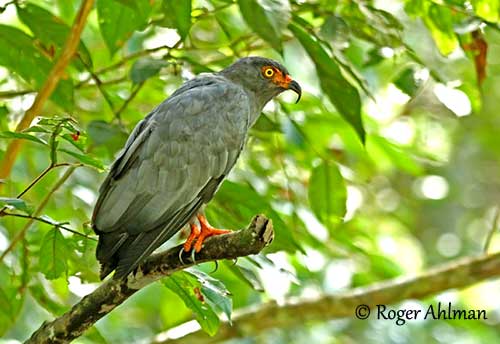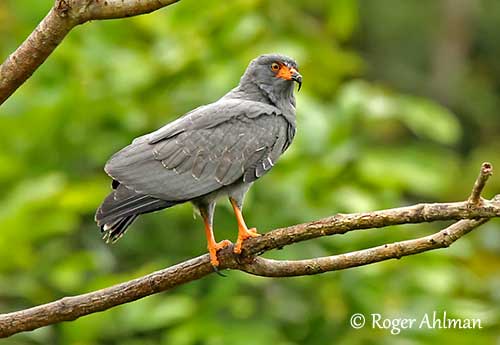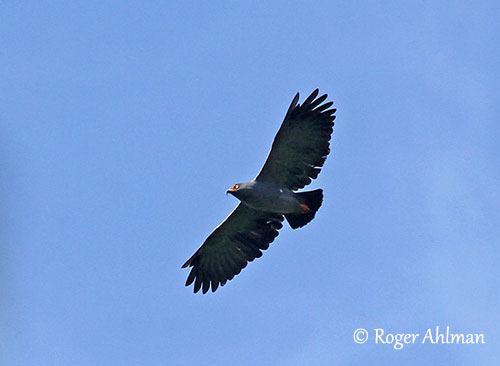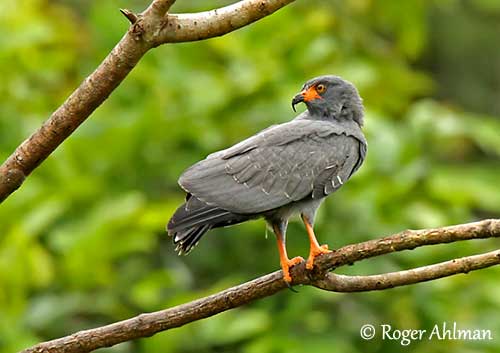
PROTECTION / THREATS / STATUS:
The Slender-billed Kite is described as uncommon and local in most parts of the range. Deforestation may affect this species, although is also frequents plantations.
The population is roughly estimated to number 670/6,700 mature individuals, and is suspected to decline slowly.
However, the Slender-billed Kite is not globally threatened and currently evaluated as Least Concern.
Fr: Milan à long bec
Ang: Slender-billed Kite
All: Hakenweih
Esp: Caracolero Plomizo
Ita: Nibbio beccosottile
Nd: Slanksnavelwouw
Sd: smalnäbbad glada
Photographer:
Roger Ahlman
Pbase Galleries Peru and Ecuador
Text by Nicole Bouglouan
Sources:
HANDBOOK OF THE BIRDS OF THE WORLD Vol 2 by Josep del Hoyo-Andrew Elliot-Jordi Sargatal - Lynx Edicions - ISBN: 8487334156
A GUIDE TO THE BIRDS OF COLOMBIA by Steven L. Hilty and William L. Brown - Princeton University Press – ISBN 069108372X
BIRDS OF VENEZUELA by Steven L. Hilty – Ed. Christopher Helm – ISBN: 0713664185
Neotropical Birds – Cornell Lab of Ornithology
The Peregrine Fund – World Centre for Birds of Prey
Wikipedia, la enciclopedia libre
Slender-billed Kite
Helicolestes hamatus
Accipitriformes Order – Accipitridae Family
INTRODUCTION:
The Slender-billed Kite was formerly included in the genus Rostrhamus, with a second species the Snail Kite.
The Slender-billed Kite is adapted to forest habitat, and frequents more wooded lakes and water bodies than the Snail Kite, but both are snail specialists. The species occurs in South America where the range is mostly fragmented from E Panama, through Colombia, Venezuela, Suriname and French Guiana.
The Slender-billed Kite is more chunky, with shorter wings and tail. It lacks the white on the tail-coverts. Its eyes are pale yellow instead of red.
It nests in a flimsy stick nest placed in tree, and both adults share the nesting duties.
The Slender-billed Kite was described first in 1821 by Coenraad Jacob Temminck, a Dutch naturalist.
This species may be affected by deforestation, but it also occurs in plantations. It is not globally threatened for the moment.
DESCRIPTION OF THE BIRD:
Biometrics:
Length: 36-41 cm
Wingspan: 80-90 cm
Weight: M: 377-448 g – F: 367-485 g
The Slender-billed Kite has uniform slaty-grey plumage overall, with mostly black primaries and rectrices. The wings are broad with rounded tips. The tail is square-tipped and fairly short.
The slender, sharply hooked bill is black. The eyes are yellowish-white. Cere, facial skin, legs and feet are orange-red. The talons are black.
Male and female are similar, but the female is slightly larger than male.

The immature resembles adult, but it shows some buff scaling overall. There are 2-3 narrow, white bands and white tip on the tail. The flight-feathers are slightly mottled greyish and rusty.
RANGE:
The Slender-billed Kite is found in E Panama and locally E through Colombia to extreme NE Ecuador, to W, N and SE Venezuela and the Guianas, and S through Amazonian Brazil to N Bolivia and E Peru.
HABITAT:
The Slender-billed Kite is found locally in swampy forest, freshwater marshes, shallow stagnant lagoons, drying ponds and seasonal floodplain forest. It also frequents plantations.
CALLS AND SONGS: SOUNDS BY XENO-CANTO
The Slender-billed Kite gives a nasal, buzzy “wheeeaaaaah” raising first and then falling. We can also hear a mewing “weeeuuu”.
BEHAVIOUR IN THE WILD:
The Slender-billed Kite feeds mainly on large snails of genus Pomacea, but it also consumes crabs.
It forages in dense shrubby areas along marshes and often hunts from low perches around shallow pools or swampy lagoons.
The snail is grasped in one or both talons and brought to a perch. The bird removes the operculum covering the entrance of the shell. Then, it tears it off and inserts its well-adapted bill into the aperture to cut the muscle, in order to extract the body before to swallow it whole.

The Slender-billed Kite breeds during the wet season. The nest is a flimsy structure of twigs placed in large tree, usually above water. The adults are monogamous and pair for life. They share the nesting duties.
During the nesting season, the birds may soar in groups of 2-5 individuals. They circle 100-300 metres in the air, sometimes up to 500 metres above the ground. One or two kites give the “wheeeaaaaah” call. These aerial displays are observed between July and October.
While one or two kites are circling, they perform series of repeated swooping dives before rising again. Chases may occur sometimes.
From observations, some courtship displays are now described. The male performs courtship feeding to the female, giving her a snail while she is perched on dead snag. The male returned five times with snail. It passes the snail to the female bill-to-bill, sometimes giving her pieces of the mollusc instead of the whole snail.
Copulation often follows the courtship feeding.
The Slender-billed Kite may be slightly nomadic, depending on water levels, but it does not migrate.
It often soars but briefly and not high, usually low above the canopy.

REPRODUCTION OF THIS SPECIES:
The breeding season takes place from June to October, during the wet season, but it may vary depending on the range.
The Slender-billed Kite nests between 9 and 20 metres above the ground, usually in large trees. The nesting site is in habitat with standing water, usually flooded during the wet season. The nest may be placed over heavy brush or sometimes over water, often a pool.
The nest is a small platform placed in the middle of a long branch or in tree fork. It is made with dead twigs, but some leafy twigs are stuck into the side of the nest, probably as camouflage. The canopy provides shade to the nest-site.
The female lays 2 eggs and both adults share the incubation that lasts about 30 days. The chicks are fed on snails and crabs torn into small pieces and passed bill-to-bill. The young are able to swallow whole snails about 17 days after hatching. They fledge at 35 days of age and are able to fly well at 40 days.
The adults defend both nest and chicks against predators such as monkeys.
